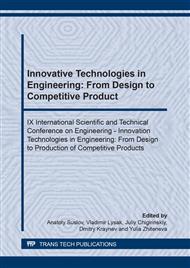[1]
P. Crawforth, Towards a Micromechanistic Understanding of Imparted Subsurface Deformation During Machining of Titanium Alloys, University of Sheffield, 2014, p.252.
Google Scholar
[2]
M.M. Kane, Basic research in technology of machinery, Minsk.: Higher School Publisher, 1987, p.232.
Google Scholar
[3]
A.D. Makarov, Optimization of cutting processes, Moskow: Machine Building Publisher, 1976, p.278.
Google Scholar
[4]
L.G. Odintsov, Hardening and finishing details by surface plastic deformation: Handbook, Moskow: Machine Building Publisher, 1987, p.328.
Google Scholar
[5]
A.G. Suslov, A.M. Dalsky, Scientific fundamentals of mechanical engineering technology, Moskow: Machine Building Publisher, 2002, p.684.
Google Scholar
[6]
N.V. Talantov, Physical basics of cutting, wear and destruction of the tool, Moskow: Machine Building Publisher, 1992, p.240.
Google Scholar
[7]
G.A. Harlamov, A.S. Tarapanov, The machining allowances: Handbook, Moskow: Machine Building Publisher, 2006, p.256.
Google Scholar
[8]
J.L. Tchigirinsky, Ensuring the accuracy and quality of surfaces in multistage machined on the basis of improved information and mathematical subsystems of technological CAD, Saratov State Technical University named after Yu.A.Gagarin, Saratov, Russia, (2014).
DOI: 10.17587/mau.16.337-343
Google Scholar
[9]
J.L. Tchigirinsky, Formalization of designing plans for the mechanical treatment of surfaces with desired properties, Proceedings of the VI Int. Scient.-tech. conf, Part 2, Rybinsk State aviation-technological university named after P.A. Soloviev, pp.330-335.
Google Scholar
[10]
J.L. Tchigirinsky, T.N. Quang, Probabilistic tables accuracy milling planes, SWorldJournal. 8:J11510 (2015) 56-61.
Google Scholar
[11]
J.L. Tchigirinsky, I.V. Firsov, P.S. Nesterenko, Influence of Finishing Methods of Treatment on Condition of Steel 36NiCrMo16 Part Surface Layer, in: A.A. Radionov (Eds.), Procedia Engineering. 206 (2017).
DOI: 10.1016/j.proeng.2017.10.627
Google Scholar
[12]
J.L. Tchigirinsky, T.N. Quang, Influence of technological factors of blade processing on the forming of the defect layer, MATEC Web of Conferences. 129 (2017).
DOI: 10.1051/matecconf/201712901020
Google Scholar


